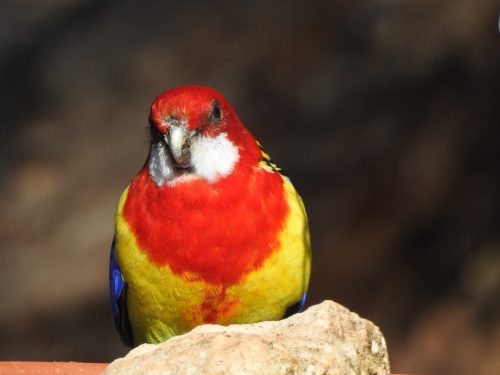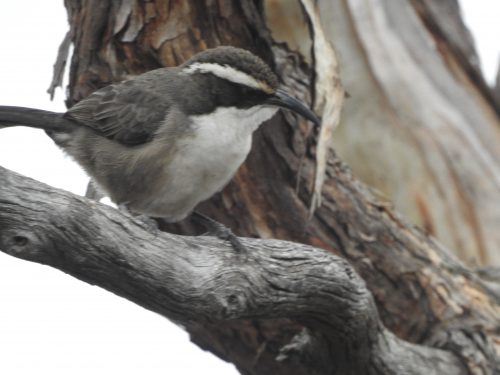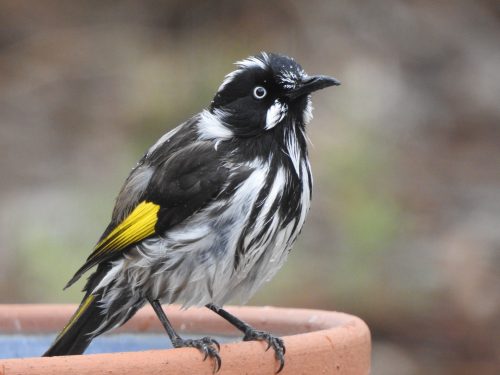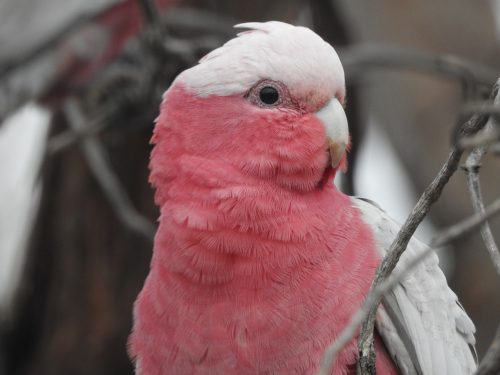Adelaide Rosella comes to visit
Yesterday we had a glorious spring morning. We spent a few hours chatting with our daughter who has been visiting over the last few days. We were enjoying being able to sit on the front verandah enjoying the beautiful day.
While chatting – and having a lovely cup of chai tea – my attention was suddenly drawn by the call of an unusual bird in the tree across the driveway. On investigation I found it was a solitary Adelaide Rosella.
This species is common throughout the Adelaide Hills some 50km to the west of Murray Bridge but not at all common around here. We do have the occasional visitor, but this only happens maybe several times a year.
As I moved towards the tree, camera at the ready, an aggressive Red Wattlebird chased the Rosella away. Can’t blame the Wattlebird; it has a nest only a few metres away – not that the Rosella was about to take and egg or chick from the nest.
The photo above was taken elsewhere some time ago.
Read some related articles:
- Eastern Rosella
- Budgerigars
- King Parrot
- Cockatoo close encounter
- So that’s who’s been eating my flowers
- Musk Lorikeets
Read through some more of my articles about parrots and lorikeets here.
Yellow Rosella
On my recent visit to Loxton in the Riverland region of South Australia I saw several Yellow Rosellas. This is a species I have not observed very often. This photos on this post are not brilliant but they are the first and only shots I have of this beautiful species.
The Yellow Rosella is a race of the Crimson Rosella. The Crimson Rosella is a bright red in colour. Similarly, the orange coloured Adelaide Rosella found in the Mt. Lofty Ranges of the Adelaide area in South Australia, is also a race of the Crimson Rosella. The Yellow Rosella and the Adelaide Rosella are known to interbreed in the Mannum-Morgan region where their ranges overlap.
Yellow Rosellas are found primarily along the Murray-Darling River systems. Their preferred habitat includes eucalyptus woodlands and nearby grasslands but usually near water. I have once recorded this species here in Murray Bridge, well downstream than any other known record.
Click on the photos to enlarge the image. Further Reading:
- Birding on a trip to Loxton
- Blue Bonnet Parrots
- Adelaide Rosella – with photos
- Eastern Rosella – another colourful parrot
UPDATE: Below is a better photo taken a few months later in New South Wales.
Adelaide Rosella
Last Sunday we were delighted to observe two Adelaide Rosellas in our garden. It has been several years since our last sighting of this species so close to home. They are infrequent visitors, coming here every few years, sometimes staying around for a few weeks before leaving again.
The Adelaide Rosella is a common parrot of the Mt Lofty Ranges and Adelaide Plains in South Australia. They are common about 30 to 40 kilometres to the west of here in Murray Bridge. In my encounters with this species, the River Murray is about the furthest east that they venture.
This species is actually a hybrid of the Yellow Rosella found further upstream along the River Murray and the Crimson Rosella of eastern Australia and the south east part of South Australia. The feathers can vary from a rich orange through to a quite pale washed out colour.
The photos shown above and below were taken at Gawler, north of Adelaide.
Click on the photo to enlarge the image.
World Environment Day
WORLD ENVIRONMENT DAY 2018
World Environment Day is celebrated on the 5th June every year. I cannot remember posting anything about this day in all of the years I have been writing on this site. This is a first for me.
I live on the edge of a large country town in South Australia. My property is about 2 hectares (5 acres) in size, with over half of it either natural scrubland (mallee trees), or planted trees and shrubs. I have lived on this property for well over 30 years and have kept a bird list for all of that time. The current list has reached 112 different species, the high number due in part to the presence of suitable habitat for a wide range of species.
Over those years we have planted many hundreds of trees and shrubs in addition to those occurring naturally. Not only have we taken delight in the wide range of birds that visit or are resident, we also enjoy the many flowering species of plants. Planting is one easy and very rewarding way of improving the environment. Even if you only have a small courtyard for a garden, having a few plants – both native and exotic – will attract our native birds for you to enjoy. The same could be said for those who live in a high-rise apartment with a balcony. Even having five or six plants in pots improves the environment, as well as helping your own well-being.
Another way I like to encourage the birds in my garden is to have several bird baths. I have placed these within close viewing distance from our sunroom. Over the years this has given me much pleasure. On really hot days, the birds flock to the baths in large numbers, either to drink or to bathe. Today I have included some recent photos taken of birds which have visited my bird baths. These were all taken when the weather was much cooler than our hot summer days, so even in cool weather, we have the delight of many birds coming to visit the bird baths.
Enjoy.
I was attacked by a duck
Earlier this week my wife and I took a short three-hour break from being with our grandchildren and family here in Sydney. We enjoy visiting Lane Cove National Park just north of the CBD. It is also the closest park to where our son lives, being only a ten-minute drive away.
We packed our lunch, a thermos, some fruit and my camera and binoculars. Can’t forget the binoculars – it’s only happened to me once in all my many years of birding. I also forgot my camera that day, but despite these drawbacks, I still managed some great birding.
After deciding on a spot to set up our folding chairs overlooking the river, we had a late morning cuppa. We were immediately joined by a Crimson Rosella and an Eastern Rosella perched in the tree above us. I scrambled for the camera, but they flew off before I managed to get the camera ready.
A few minutes later our peaceful relaxation was disturbed by the raucous calls of a small flock of Sulphur-crested Cockatoos flying overhead. I then noticed one of them perched at the entrance of a large hollow in a nearby gum tree. Every few seconds he would screech noisily, raising his wings as he called. Something was annoying him – not sure what.
Within a few minutes, we were joined in our picnic by several Pied Currawongs. They eyed off our mugs and bags looking for something to gobble up. They were not successful. Neither were the Laughing Kookaburras which also joined the party.
Earlier, as we pulled into the car park, I noticed a walking trail leading off up the hill. I remember walking that trail with other family members one Christmas some years ago on another visit. I checked my bird database; it was December 2008. It was time to investigate this track once again. Ignoring the hip and leg pain caused by the intervening years, I steadily climbed the track until I had a good view of the river below.
Numerous small brown birds chirped away in the vegetation, but none posed long enough for photos – and not even long enough for good views through my binoculars. Most of them were undoubtedly Brown Thornbills, a species I have seen here a few times before. The only other good sighting was a very brief view of a solitary Red-browed Finch. Never mind – I managed a few good photos of some flowers and a lovely butterfly. I left by butterfly book home so I can’t identify it.
As we were leaving, I drove slowly through the park to the exit gate. This took us quite close to the Lane Cove river at times. Not far from the gate I was suddenly aware of a male Australian Wood Duck heading aggressively towards our car as we passed by, head down, neck stretched out and I think he was hissing. He looked quite fierce for a few seconds. Pity I didn’t get this on my camera. This reminded me of another incident on the other side of the river a few days earlier. Another male Australian Wood Duck hissed at me in a similar fashion. I understood completely; he was guarding the female and three juveniles feeding nearby.
Good birding,
Trevor
PS: why not join my regular monthly newsletter by subscription? Details are to be found below the comments.









